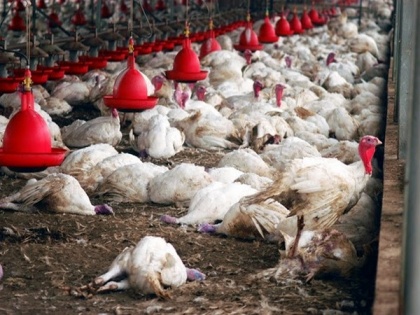Bird Flu or Inhumane Farming; Animals in Farms are at a Higher Risk of Diseases
By ANI | Published: January 13, 2021 04:34 PM2021-01-13T16:34:45+5:302021-01-13T16:45:02+5:30
World Animal Protection has received appalling reports that large numbers of poultry animals have been culled and more are being planned to avoid the risk of Bird Flu spread.

Bird Flu or Inhumane Farming; Animals in Farms are at a Higher Risk of Diseases
World mal Protection has received appalling reports that large numbers of poultry mals have been culled and more are being planned to avoid the risk of Bird Flu spread.
World mal Protection is aware that huge number of chickens are being culled without following OIE recommended guidelines. We strongly condemn inhumane methods of culling of chickens for disease control purposes. With Bird flu spreading around the country, all available resources must be put into ensuring that affected mals are treated humanely.
mal Welfare is the fundamental pillar of disease prevention
mals in farms are at high risk of diseases. Wherever they are squashed together and stressed, the diseases spread readily. Experts agree that mal welfare is the fundamental pillar of disease prevention. Chickens and other farm mals are not cogs in a machine. They are living, breathing beings who feel pain, suffering and joy. There is no excuse for cruelty on farms or during slaughter. Chickens must be well handled and effectively stunned to kill them (electrocution) with trained use of regulated devices. Injections or other methods that paralyse but don't make chickens unconscious or painlessly kill them, are not humane. Once confirmed dead, mals must be disposed of responsibly, as dumping in grounds, rivers, or elsewhere spreads disease further.
Inhumane farming is causing mal suffering
Inhumane farming is the world's biggest cause of mal suffering, and it's getting worse. Right now, more than 70 billion mals are farmed for food each year, most of them live in conditions that mean they can't live good lives. Such farms are closely linked to other critical concerns, including zoonotic disease outbreaks, water pollution, overuse of antibiotics, and antimicrobial resistance development.
While high mal density within farms is a risk factor for the amplification of disease, the geographic concentration of farms in the same region is a risk for disease spread. Intensive production is often associated with large numbers of mals on a relatively small area of land.
Live mal Markets are responsible for virus transmission
Live mal markets are hubs in which mals from different sources are put into direct and indirect contact. Emerging and re-emerging pathogens are most likely to have the broadest host ranges, and the diversity of closely held mals in live markets facilitates cross-species virus transmission. When mals are gathered tightly together, under high stress, the viral load is amplified. Millions of live birds are brought to markets in Asian urban centres and slaughtered every day. Infected birds may be sold and slaughtered before showing disease signs or dying of infection.
"World mal Protection is deeply concerned about the culling of chickens and other poultry birds across the country. World mal Protection urges the government and food industry to provide sustainable and humane consumer options by transitioning to proven humane and sustainable farming models. These systems afford farm mals good lives and, in conjunction with the increased consumption of plant-based proteins, can safeguard the planet and its inhabitants," said Gajender K Sharma, Country Director, World mal Protection India.
This story is provided by NewsVoir. will not be responsible in any way for the content of this article. (/NewsVoir)
( With inputs from ANI )
Disclaimer: This post has been auto-published from an agency feed without any modifications to the text and has not been reviewed by an editor
Open in app